The world’s $12.5 trillion informal economy covers nearly every corner of the world, seeing the highest concentration in emerging economies.
Yet in absolute terms, China, the U.S. and India are home to the largest black markets—covering everything from street vendors to illegal activities that evade governmental oversight. Overall, this generates lower tax revenue and poorer working conditions given the absence of worker protections, leaving millions exposed to poor working conditions.
This graphic, via Visual Capitalist’s Dorothy Neufeld, shows the largest shadow economies in the world, based on data from the EY Global Shadow Economy Report 2025.
Measuring the Informal Economy
While measuring the size of show economy activity is challenging, Ernst & Young used more than 70 variables to analyze unobserved economic activities in a country.
Primarily, a currency demand approach was used to examine cash use patterns across 131 jurisdictions covering 97.2% of world GDP. This is largely due to the informal economy driving significant demand for cash, especially high-denomination bills.
China’s Informal Economy is the World’s Largest
Since 2004, workers employed in China’s informal economy have nearly doubled, reaching approximately 200 million.
Driving this trend are jobs are found in the labor-intensive services sector, such as drivers, nannies, and roadside repairmen. As a result, China’s income tax revenue accounts for about 6% of GDP—far lower than the 24% OECD average.
Ranking in second is the U.S. shadow economy, valued at $1.4 trillion. Overall, states with lower real GDP and higher regulatory burdens tend to have more active underground economies.
Meanwhile, Brazil leads in Latin America, with a shadow economy valued at $448 billion. In Europe, Germany is home to the largest at $308 billion, equal to 6.8% of GDP.
To learn more about this topic from a country-based perspective, check out this graphic on the size of the shadow economy by country.
Tyler Durden
Mon, 06/02/2025 – 02:45
Click this link for the original source of this article.
Author: Tyler Durden
This content is courtesy of, and owned and copyrighted by, https://zerohedge.com and its author. This content is made available by use of the public RSS feed offered by the host site and is used for educational purposes only. If you are the author or represent the host site and would like this content removed now and in the future, please contact USSANews.com using the email address in the Contact page found in the website menu.








